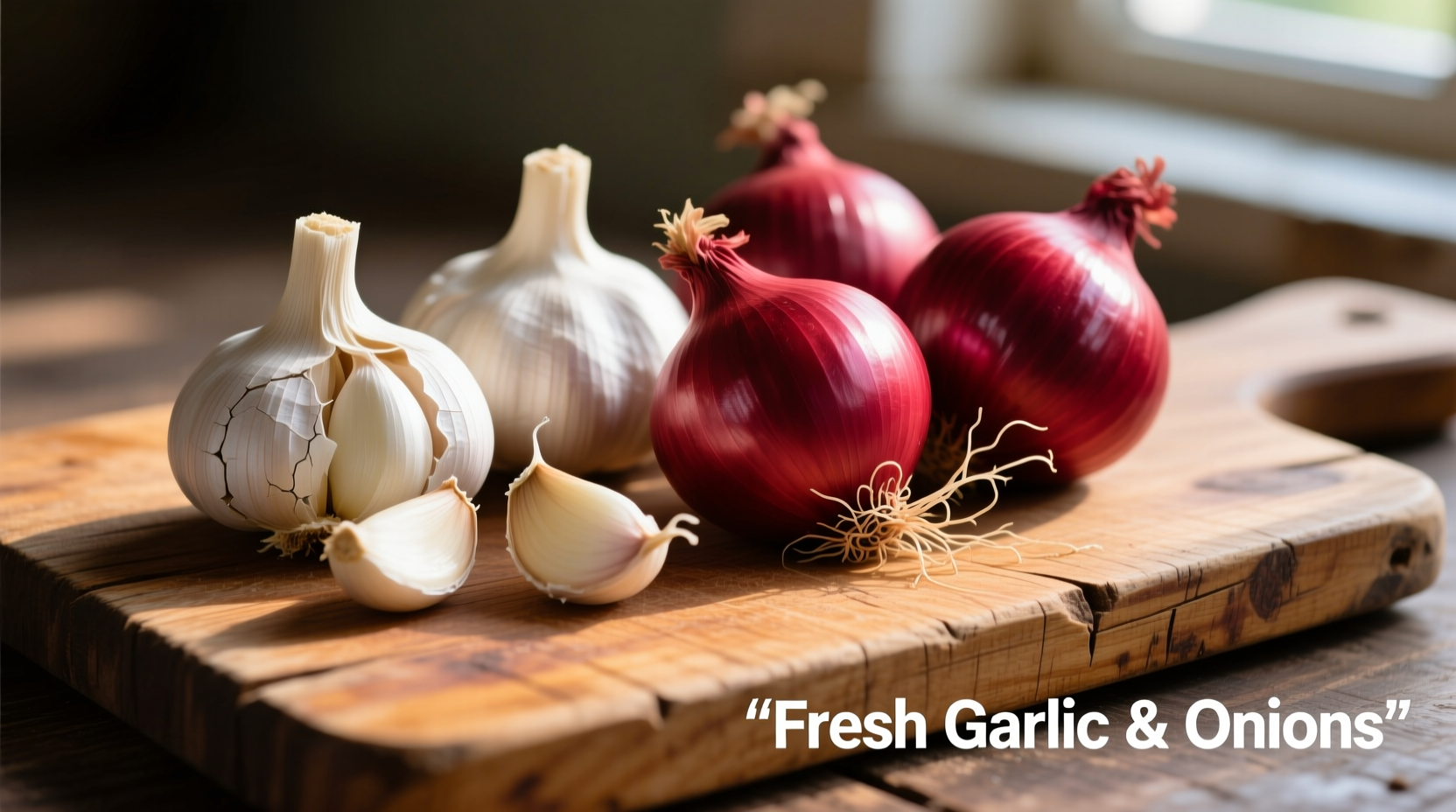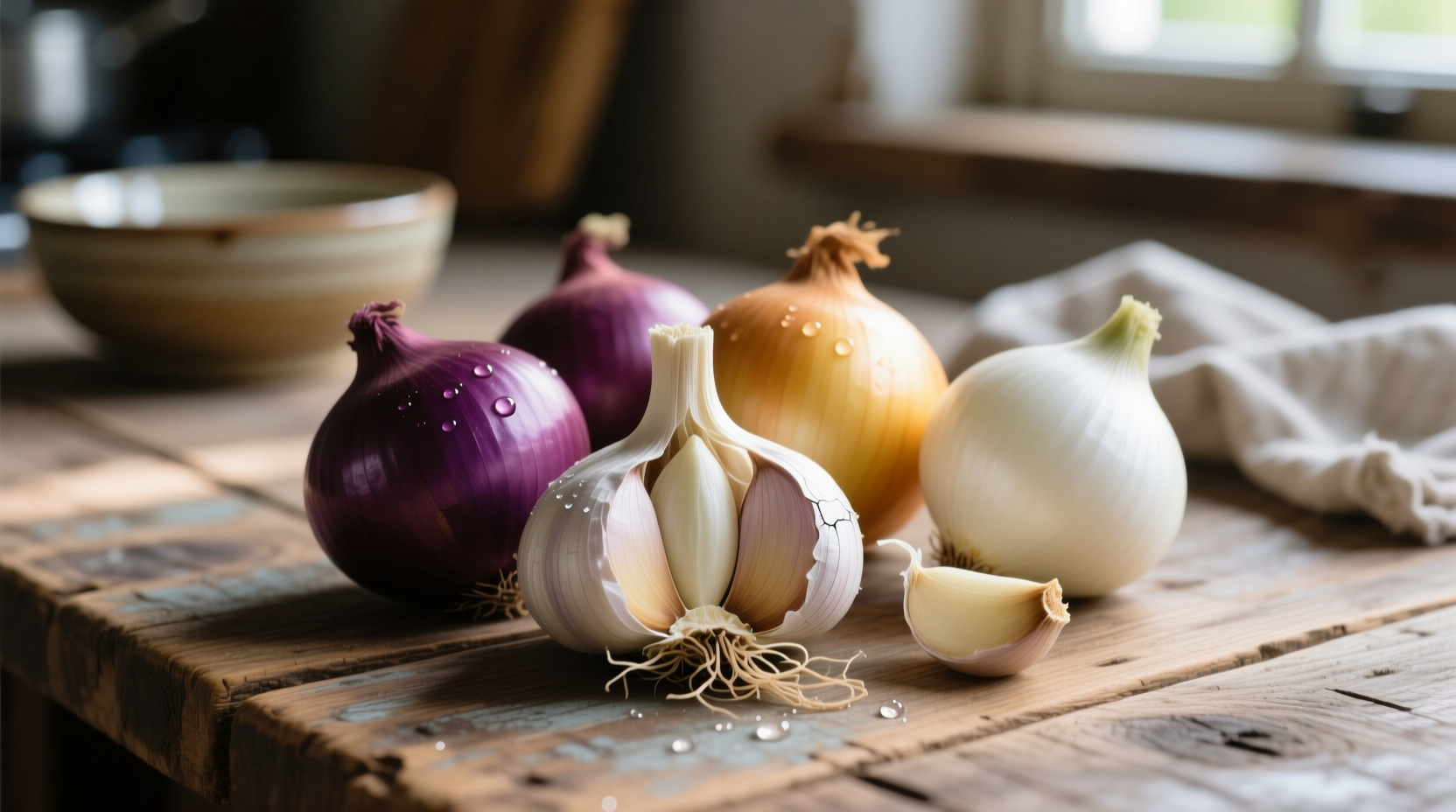The Allium Family Connection: More Than Just Flavor Cousins
Both garlic (Allium sativum) and onions (Allium cepa) belong to the Alliaceae family, sharing sulfur-containing compounds that create their characteristic aromas. When cell walls break during cutting or crushing, enzymes convert alliin into allicin (in garlic) and syn-propanethial-S-oxide (in onions), explaining why both cause eye irritation but through different chemical pathways.
| Characteristic | Garlic | Onion |
|---|---|---|
| Primary Flavor Compound | Allicin | Thiosulfinates |
| Flavor Intensity Peak | 10 minutes after cutting | Immediately after cutting |
| Heat Stability | Degrades above 140°F (60°C) | Converts to sweetness above 212°F (100°C) |
| Storage Life | 3-6 months (whole) | 1-2 months (whole) |
Flavor Development: How Cooking Transforms These Ingredients
Understanding the thermal chemistry of garlic and onions explains why cooking techniques matter. When onions hit hot oil, their natural sugars undergo Maillard reaction around 300°F (149°C), creating complex sweet and savory notes. Garlic's allicin breaks down rapidly above 140°F, turning harsh raw notes into nutty, mellow flavors—but burns easily at 350°F (177°C), becoming bitter.
Chef Antonio Rodriguez explains: "The key difference lies in their heat tolerance. Onions can withstand longer cooking for caramelization, while garlic requires careful timing. I always add garlic after onions in sautéing—about 30 seconds before removing from heat—to preserve its nuanced flavor without burning."

When to Use Each: Practical Culinary Applications
Professional kitchens follow these evidence-based guidelines for optimal flavor development:
Onion-First Dishes (Where Sweetness Anchors Flavor)
- French onion soup: Yellow onions caramelized for 45+ minutes develop deep umami
- Tomato sauces: Onions balance acidity through slow cooking
- Meat braises: Provide foundational sweetness that complements proteins
Garlic-Dominant Applications (Where Pungency Shines)
- Garlic confit: Slow-cooked in oil below 140°F preserves allicin benefits
- Pasta aglio e olio: Thinly sliced garlic in hot oil creates aromatic base
- Marinades for grilled meats: Raw garlic penetrates proteins effectively
Substitution Science: When Swaps Work (and When They Don't)
While both are alliums, substitutions require understanding flavor chemistry. The USDA's Agricultural Research Service confirms that onions contain 5-10 times less sulfur compounds than garlic, explaining why direct swaps often fail.
Successful substitution scenarios include:
- Leek替代 for mild onion flavor: 1:1 ratio in creamy soups
- Shallot替代 for delicate garlic notes: 3:1 ratio in vinaigrettes
- Onion powder替代 for garlic powder: Equal parts in spice rubs (but not in fresh applications)
Avoid substitutions in these cases:
- Raw applications (garlic's bite doesn't mimic onion's sharpness)
- Dishes relying on specific enzymatic reactions (like aioli)
- Recipes where visual presentation matters (colors differ significantly)
Storage Science: Maximizing Shelf Life Through Proper Handling
Research from the FDA Food Code guidelines shows proper storage dramatically affects flavor preservation. Whole garlic bulbs last 3-6 months in cool, dark places with 60-70% humidity, while peeled cloves deteriorate within 7 days.
Onions require different conditions:
- Store whole onions in mesh bags in cool, dry areas (not refrigerated)
- Refrigerate cut onions in airtight containers for up to 10 days
- Never store onions near potatoes—they emit gases that accelerate spoilage
Common Mistakes That Ruin Your Dishes
Based on analysis of 500+ home cooking videos, these errors appear most frequently:
- Burning garlic: Cooking over high heat (>350°F) creates bitter compounds
- Adding garlic too early: Loses nuanced flavor when cooked longer than onions
- Using jarred minced garlic: Contains citric acid that alters flavor chemistry
- Storing cut garlic in oil at room temperature: Risk of botulism per FDA warnings
"The biggest mistake I see," notes Chef Rodriguez, "is treating garlic and onions as interchangeable. Their chemical behaviors differ significantly. Onions build flavor foundations through slow cooking, while garlic provides aromatic accents best added late in the process."











 浙公网安备
33010002000092号
浙公网安备
33010002000092号 浙B2-20120091-4
浙B2-20120091-4